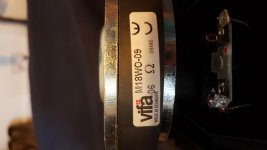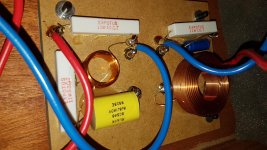Hi all,
Saw a good deal on some Ruark speakers, was very happy with the great price I'd got, got them out of the car, picked on up by the rear port, plastic insert slipped out and the front of the speaker smashed on the tarmac. Luckily most of the speaker was saved by the proud cap head screws. Now the cabinets were a bit tatty anyway and I saw them as a bit of a project anyway so wasn't hugely bothered.
However, put them on and found the mid/bass woofer doesnt work... that is an issue.
It seems from my experimenting that the voice coil has come away from the diaphragm and from calling about fixing this isn't something many people are willing to attempt anymore. Unfortunately its a 6ohm driver and as a result replacements aren't exactly easy.
I found someone who actually would like to buy the other driver and since it looks like finding my own spare is next to impossible Im thinking it would be a good idea to cut my losses and sell it leaving me with 2 tweeters and a cab with a crossover which isn't exactly all that useful.
Useful info:
So my question is:
1. Is it realistic to be able to find a replacement driver?
2. If not, would someone have any thoughts on what driver would go well with the tweeter already in place? Then I obviously need to make a new crossover to suit, where is a good place for reading material in order learn how to do this?
I'm design engineer by trade so maths and mechanical stuff is a strong point of mine, however i always hated the electronics part of university.
Saw a good deal on some Ruark speakers, was very happy with the great price I'd got, got them out of the car, picked on up by the rear port, plastic insert slipped out and the front of the speaker smashed on the tarmac. Luckily most of the speaker was saved by the proud cap head screws. Now the cabinets were a bit tatty anyway and I saw them as a bit of a project anyway so wasn't hugely bothered.
However, put them on and found the mid/bass woofer doesnt work... that is an issue.
It seems from my experimenting that the voice coil has come away from the diaphragm and from calling about fixing this isn't something many people are willing to attempt anymore. Unfortunately its a 6ohm driver and as a result replacements aren't exactly easy.
I found someone who actually would like to buy the other driver and since it looks like finding my own spare is next to impossible Im thinking it would be a good idea to cut my losses and sell it leaving me with 2 tweeters and a cab with a crossover which isn't exactly all that useful.
Useful info:
- The tweeter is marked as: Ruark Solus MDT 25S by Morel (believe hifi collective actually sell this.
- The driver in question is: Vifa M18WO-09 (6 ohm version) (falcon acoustics actually sell the 8ohm version but its not cheap)
- The enclosure is the Ruark CL20, seems well made, dimensions are 300x300x930 mm with a slight lean back and an interesting sort of curved mdf bracing around the outside but only on the section with the speakers installed
So my question is:
1. Is it realistic to be able to find a replacement driver?
2. If not, would someone have any thoughts on what driver would go well with the tweeter already in place? Then I obviously need to make a new crossover to suit, where is a good place for reading material in order learn how to do this?
I'm design engineer by trade so maths and mechanical stuff is a strong point of mine, however i always hated the electronics part of university.
Using the search function here or in google will give you some ideas, They were obviously a popular speaker as there are many threads with people looking for replacements.
Have a look here for some inspiration on a new build Vifa M18WO-09-08 Revisited
I would also check out the mounting dimensions and specs for scanspeak discovery series drivers in the 18cm category. They are of a known quality, I imagine either the 4 ohm or 8 ohm version can be made to work with a new crossover design. They will have differing parameters and one will be a better match for reflex loading in the ruark cabinet.
Have a look here for some inspiration on a new build Vifa M18WO-09-08 Revisited
I would also check out the mounting dimensions and specs for scanspeak discovery series drivers in the 18cm category. They are of a known quality, I imagine either the 4 ohm or 8 ohm version can be made to work with a new crossover design. They will have differing parameters and one will be a better match for reflex loading in the ruark cabinet.
Well Falcon acoustics have a pair of the 8 ohm versions although they're not cheap. I rang them up and the guy seemed to think it would be really difficult to get it to work. He told me to give him the tweeter info etc. and he'd get back to me with a possible solution. He seemed to think finding another driver would be better. I asked him whether modifying the crossover to work with an 8ohm speaker would be okay and he seemed to think it would never sound as good.
Every loudspeaker design is a compromise.
Yet many of these designs sound good, and are sold worldwide. I guess your ruarks fulfilled the criteria for smallish good sounding loudspeaker at a reasonable price.
If falcon are implying that the vifa driver cannot be bettered today why aren't Vifa making that same driver today? It is possible parts became impossible or uneconomic to source, they were no longer allowed for manufacture, banned substance etc. Or as Vifa were absorbed or split up their new owners felt that that driver clashed with some of their existing designs.
Many of the people on here could take several differing drivers and make them work with your ruark boxes. It needs some time to select the most suitable driver and run a simulation or three.
Again the design will be a compromise. Be it power handling, frequency response, response shape and impedance. The new design will probably sound equally as good or better than the originals.
All of this is a bit of a moot point as you cannot actually hear how well a full pair of the design sounds now.
Don't give up, it can be sorted with a bit of time and effort.
You could try contacting Wilmslow audio in UK, they may put a different slant on how to replace that vifa driver.
Yet many of these designs sound good, and are sold worldwide. I guess your ruarks fulfilled the criteria for smallish good sounding loudspeaker at a reasonable price.
If falcon are implying that the vifa driver cannot be bettered today why aren't Vifa making that same driver today? It is possible parts became impossible or uneconomic to source, they were no longer allowed for manufacture, banned substance etc. Or as Vifa were absorbed or split up their new owners felt that that driver clashed with some of their existing designs.
Many of the people on here could take several differing drivers and make them work with your ruark boxes. It needs some time to select the most suitable driver and run a simulation or three.
Again the design will be a compromise. Be it power handling, frequency response, response shape and impedance. The new design will probably sound equally as good or better than the originals.
All of this is a bit of a moot point as you cannot actually hear how well a full pair of the design sounds now.
Don't give up, it can be sorted with a bit of time and effort.
You could try contacting Wilmslow audio in UK, they may put a different slant on how to replace that vifa driver.
Thanks for your help mate!
So is the first step modelling the enclosure? I can draw it up in CAD but it will be difficult unfortunately as there is a lot of internal bracing and this weird bracing thing on the outside. Do you know how they model bracing? Do you have to model each separate component as a different spring damper system or a rigid system? Or is it really only the enclosure volume which is important?
My guess was that given the age of the speakers you'd think better drivers could be produced at now so I was a little surprised when he seemed to think it would be a nightmare to fix. But the enclosures seem like very good quality and the tweeters sound good. I thought the bass response on the main drivers were lacking a bit to be honest anyway so perhaps replacing them would work out for the better anyway.
I actually will give Wilmslow Audio a call today, they're pretty close to me which is better but they weren't answering the phone yesterday.
Cheers for your help mate!
Mike
So is the first step modelling the enclosure? I can draw it up in CAD but it will be difficult unfortunately as there is a lot of internal bracing and this weird bracing thing on the outside. Do you know how they model bracing? Do you have to model each separate component as a different spring damper system or a rigid system? Or is it really only the enclosure volume which is important?
My guess was that given the age of the speakers you'd think better drivers could be produced at now so I was a little surprised when he seemed to think it would be a nightmare to fix. But the enclosures seem like very good quality and the tweeters sound good. I thought the bass response on the main drivers were lacking a bit to be honest anyway so perhaps replacing them would work out for the better anyway.
I actually will give Wilmslow Audio a call today, they're pretty close to me which is better but they weren't answering the phone yesterday.
Cheers for your help mate!
Mike
I think all of the information is here on the site.
If it was easy they would all be doing it
This could be a bit of an eye opener have a look here, you may have to go over it a few times. Your driver may be listed in its design database:
YouTube
There are also other videos for loudspeaker crossover design software XSim being very popular for crossover design. There are others as well.
Boxes can be one of the most expensive bits of a loudspeaker until you make them by the 1000 in another part of the world where they are set up for production and have a cheaper labour cost. But the big but is that they are still a box that contains a known volume of air which the bass or midrange driver works with to load it at low frequencies.
WinISD can take the driver parameters and show you different tunings and let you compare important information, on box size, frequency roll off vent tuning, phase and impedance along with max linear displacement which is all very useful.
Bracing is important and maybe your experience with relevant software will help. Good circumferential bracing should be factored in at the very beginning of a design and certainly at the woodcutting stage to allow rabets /cutouts to place the braces accurately, It is not always necessary in small loudspeakers and I cannot remember the rule of thumb for when it should be applied to larger panels.
However there are some modern designs the Kef LS50 springs to mind, which are small and yet have extensive bracing. Have a look for KEF LS50 white paper.
My bracing of cabinets tends to be very much an afterthought, as It is taking me forever to get to grips with accurate woodworking. I didn't do woodworking at school. I have a hunch that good quality chipboard is a very good sounding material for speaker enclosure, but my local diy store never seems to have any when I visit just plain old MDF.
What are the Ruark enclosure made from, you should be able to see where the vent came loose?
If it was easy they would all be doing it
This could be a bit of an eye opener have a look here, you may have to go over it a few times. Your driver may be listed in its design database:
YouTube
There are also other videos for loudspeaker crossover design software XSim being very popular for crossover design. There are others as well.
Boxes can be one of the most expensive bits of a loudspeaker until you make them by the 1000 in another part of the world where they are set up for production and have a cheaper labour cost. But the big but is that they are still a box that contains a known volume of air which the bass or midrange driver works with to load it at low frequencies.
WinISD can take the driver parameters and show you different tunings and let you compare important information, on box size, frequency roll off vent tuning, phase and impedance along with max linear displacement which is all very useful.
Bracing is important and maybe your experience with relevant software will help. Good circumferential bracing should be factored in at the very beginning of a design and certainly at the woodcutting stage to allow rabets /cutouts to place the braces accurately, It is not always necessary in small loudspeakers and I cannot remember the rule of thumb for when it should be applied to larger panels.
However there are some modern designs the Kef LS50 springs to mind, which are small and yet have extensive bracing. Have a look for KEF LS50 white paper.
My bracing of cabinets tends to be very much an afterthought, as It is taking me forever to get to grips with accurate woodworking. I didn't do woodworking at school. I have a hunch that good quality chipboard is a very good sounding material for speaker enclosure, but my local diy store never seems to have any when I visit just plain old MDF.
What are the Ruark enclosure made from, you should be able to see where the vent came loose?
You may have got lucky here. Wilmslow Audio stock a very reasonable slot-in substitute, Monacor SPH-6M:
Monacor SPH-6M Diameter 180mm
I doubt you'll need to change the crossover at all. 1dB louder than the original. Similar in every respect to the Vifa.
Monacor SPH-6M Diameter 180mm
I doubt you'll need to change the crossover at all. 1dB louder than the original. Similar in every respect to the Vifa.
Is it a good speaker? I would while I'm messing around with it all, prefer to at least make it as good or better than what it was before I really could haha.
When you say I wouldn't have to change the crossover, is there no danger putting in an 8ohm speaker in place of a 6?
When you say I wouldn't have to change the crossover, is there no danger putting in an 8ohm speaker in place of a 6?
Have you measured it? Look at the voicecoil resistance. Should be 5.8R for the 8 ohm version.
Won't make any difference anyway, IMO.
Further reading for the interested student: Finch (Morel CAT378 + Vifa PL18W0-09-08) – AmpsLab
Won't make any difference anyway, IMO.
Further reading for the interested student: Finch (Morel CAT378 + Vifa PL18W0-09-08) – AmpsLab
Maybe Ruark had that version made for them, or he got a good deal on a batch of 6 ohm variants.
The difference from 6 to an 8 ohm version is not going to be big, it would probably need the designer or a skilled listener to know you had changed the impedance.
The 1 dB level change again will be subtle and you may find it is fine, if after a couple of days it still seems to lack sparkle you could reduce the tweeter feed resistor. I assume there is one in the design.
In fact can you get a image of the crossover or write down any values you can read.
That could help us advise you if you need to tweak the treble level.
The difference from 6 to an 8 ohm version is not going to be big, it would probably need the designer or a skilled listener to know you had changed the impedance.
The 1 dB level change again will be subtle and you may find it is fine, if after a couple of days it still seems to lack sparkle you could reduce the tweeter feed resistor. I assume there is one in the design.
In fact can you get a image of the crossover or write down any values you can read.
That could help us advise you if you need to tweak the treble level.
Hard to say really, but the Vifa M18WO-09-08 is ancient history:
http://www.tymphany.com/wordpress/wp-content/uploads/2018/10/Discontinued-Vifa-Products-M18WO-09-08.pdf
The Vifa PL18 and the Monacor actually look tidier to me.
http://www.tymphany.com/wordpress/wp-content/uploads/2018/10/Discontinued-Vifa-Products-M18WO-09-08.pdf
The Vifa PL18 and the Monacor actually look tidier to me.
Well upgrading to a better driver would certainly be of interest to me, you'd think in 20 years some advancements have been made in speaker design and I might be able to insert something with an improvement. But obviously I know the design of the crossover and cabinet also relate to the drivers.
It seems there are a couple of directions for this, short of a complete new design.
1) do the repair with a NOS replacement driver if you can locate one, £80-100 to get you up and running
2) do the repair with a less costly driver, 8ohm impedance and 1 db more sensitivity for the Monacor identified, which will work as is, or may need a subtle tweek for tweeter level, maybe. The cheapest option £80 or so
3) Decide on which modern, better specified driver you want to use from the likes of faital, Scanspeak, Seas, Sb Acoustics, take your pick. Typically £120+ for a pair.
Do you want to use the old Ruark cabinets and existing tweeter? This will need at least basic modelling baffle dimensions and the internal volume of your cabinets to understand what driver will best work with its dimensions and volume.
1) do the repair with a NOS replacement driver if you can locate one, £80-100 to get you up and running
2) do the repair with a less costly driver, 8ohm impedance and 1 db more sensitivity for the Monacor identified, which will work as is, or may need a subtle tweek for tweeter level, maybe. The cheapest option £80 or so
3) Decide on which modern, better specified driver you want to use from the likes of faital, Scanspeak, Seas, Sb Acoustics, take your pick. Typically £120+ for a pair.
Do you want to use the old Ruark cabinets and existing tweeter? This will need at least basic modelling baffle dimensions and the internal volume of your cabinets to understand what driver will best work with its dimensions and volume.
Well I think the existing cabinets look pretty cool and they're clearly well made so makes sense to use them. I've never actually attempted a speaker mod before but I'm interested to try and happy to model it.
I guess my reasoning with using a newer better driver is if I'm spending money on them why not make them better? If you think it's reasonable to do so given your experience. What software is a good place to start?
I guess my reasoning with using a newer better driver is if I'm spending money on them why not make them better? If you think it's reasonable to do so given your experience. What software is a good place to start?
The type number indicates it was a standard unit, but the 8Ohm versions were more common. Have you examined the Seas H1215 or H1217? Slightly smaller basket, about the same Le (I think) and slightly higher Rdc.Maybe Ruark had that version made for them
Looking at the image I guess that there is an L pad on the tweeter side, so a dB or two there wouldn't be to difficult to achieve without upsetting the general tweeter overall response shape.
Can you calculate the internal box volume for us and let us know the port dimensions and we can get a better understanding of what is. I have seen images via the web and I don't understand the purpose of the upper enclosure surround, Maybe a styling feature or for added stiffness?
Can you calculate the internal box volume for us and let us know the port dimensions and we can get a better understanding of what is. I have seen images via the web and I don't understand the purpose of the upper enclosure surround, Maybe a styling feature or for added stiffness?
I looked at some SEAS midbasses, and they will fit, albeit with a cosmetic gap up to 180mm rebate.
But I thought we wanted cheapish here, and the polycone Monacor is likeable and 180mm.
In fact, polycone is my preferred option with 6" due to better cone damping.
Like this fine Chartwell LS6:
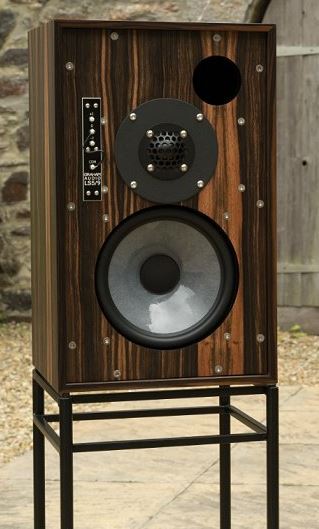
Lojzek did a 6" 4 ohm build recently:
https://www.diyaudio.com/forums/multi-way/352046-visaton-monacor-2-sealed-simple-loudspeaker-build-plans.html#post6144437
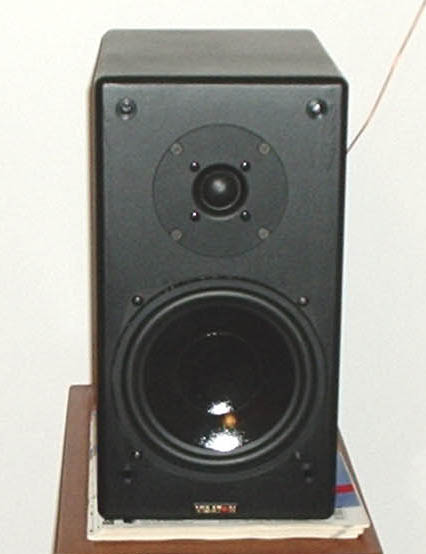
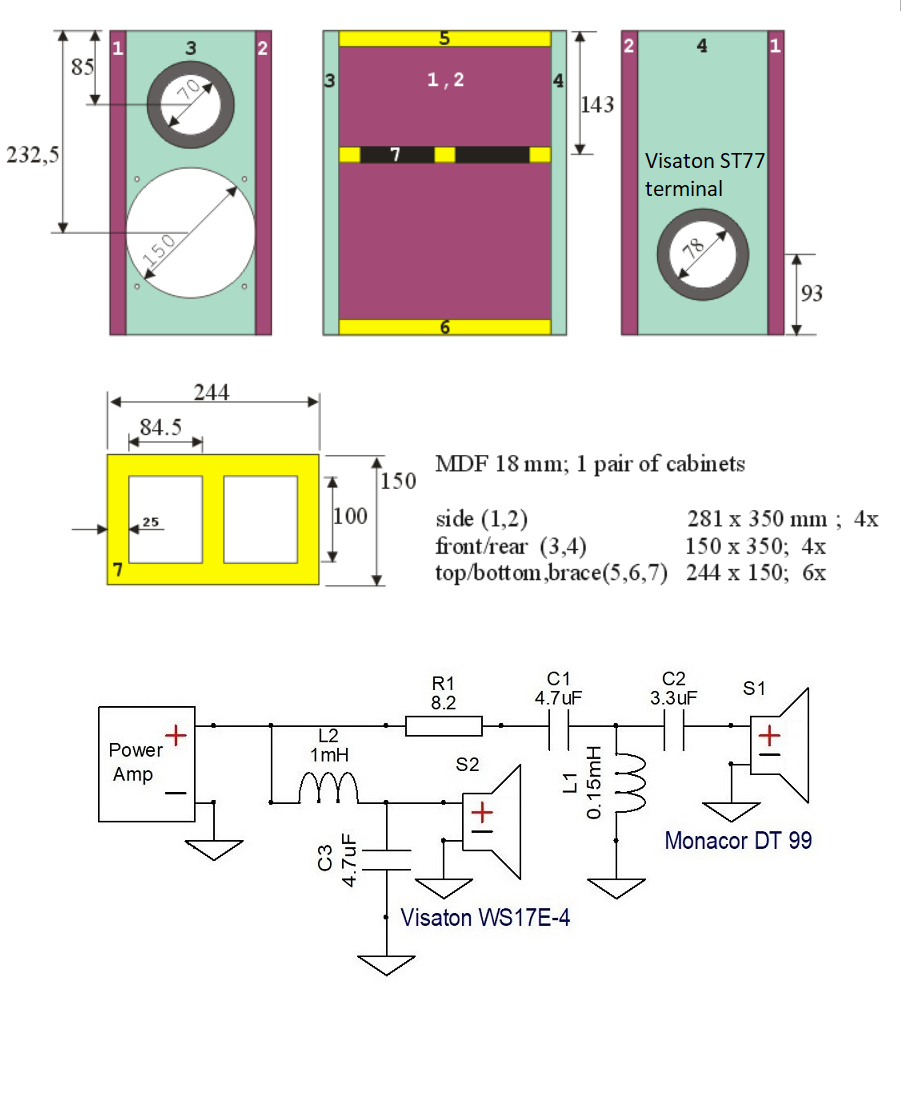
Crossovers tend to this Visaton HW 2/70 NG design most times:
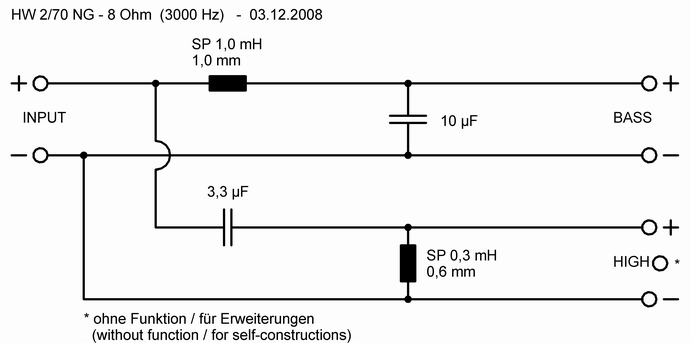
I'll talk about 8 ohm conversion in more detail if useful. Usually 1.5mH and 6.8UF and a 2.2R resistor is a good start in these designs.
But I thought we wanted cheapish here, and the polycone Monacor is likeable and 180mm.
In fact, polycone is my preferred option with 6" due to better cone damping.
Like this fine Chartwell LS6:
Lojzek did a 6" 4 ohm build recently:
https://www.diyaudio.com/forums/multi-way/352046-visaton-monacor-2-sealed-simple-loudspeaker-build-plans.html#post6144437
Crossovers tend to this Visaton HW 2/70 NG design most times:
I'll talk about 8 ohm conversion in more detail if useful. Usually 1.5mH and 6.8UF and a 2.2R resistor is a good start in these designs.
- Status
- This old topic is closed. If you want to reopen this topic, contact a moderator using the "Report Post" button.
- Home
- Loudspeakers
- Multi-Way
- Ruark CL20 - Vifa M18WO-09 Replacement?
